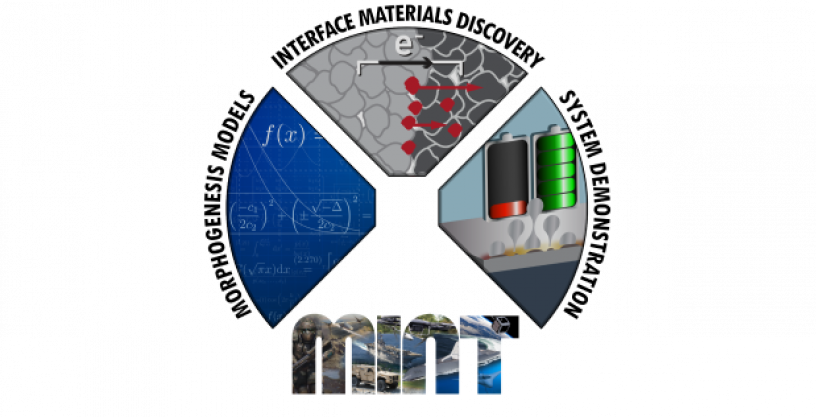
Advanced math modeling to enable new designs for persistent batteries, anti-corrosion coatings
Jun 10, 2021
Persistent battery power and anti-corrosion coatings are key to sustaining military operations. Batteries power everything from tactical radios and handheld devices to unmanned systems. Protective coatings shield flight surfaces, rotor blades, and ship hulls from corrosion caused by humidity, sand, and saltwater. A challenge to creating more persistent batteries and coatings, however, is the inability to address microscopic irregularities that form at the interfaces of electrochemical materials.
DARPA today announced the Morphogenic Interfaces (MINT) program, which seeks to enhance the persistence of high-performance electrochemical systems by developing self-regulating interfaces that exploit detrimental local gradients to maintain optimal functionality over the planned operational life cycle. The inspiration for pursuing novel, adaptive electrochemical interfaces comes from biology and the concept of morphogenesis, which explains the process of how cells and tissues take shape. A Proposers Day webinar for interested proposers is scheduled for July 9, 2021, from 11:00 a.m. to 3:00 p.m. EDT.
“Batteries and anti-corrosion coatings both rely on electrochemical reactions that take place at material interfaces from the atomic through millimeter scale,” said Vishnu Sundaresan, MINT program manager in DARPA’s Defense Sciences Office. “It’s at these microscopic interfaces that high energy density solid-state batteries and novel corrosion resistant coatings/alloys run into problems. In solid-state batteries, as positively charged ions – lithium ions, for example – are deposited on the negative electrode during charging and then on the positive electrode during discharging, changes to the morphology of the interface leads to nanoscale voids at solid/solid ion transfer interfaces. With each discharge/recharge cycle the number and size of voids at the interface increase rapidly and diminishes battery capacity until the battery can no longer hold a charge. Solving the problem of voids at these interfaces is key to enabling practical solid-state batteries, which have high theoretical energy density and don’t use organic liquid electrolytes that are common in lithium-ion batteries used widely today. Because solid-state batteries do not use liquid electrolytes, they’re inherently safe from catastrophic fire up to 150 degrees Celsius.”
Corrosion resistant coatings/alloys on ship hulls, power plants and critical aircraft surfaces undergo similar electrochemical reactions at solid/liquid and solid/vapor interfaces during cyclical loading, a process that happens anywhere from billions to trillions of times (cyclical loads) during the lifetime of the structure. In aggressive corrosive environments, nanoscale pits that form at the material interface due to corrosion penetrate into the underlying metal and rapidly expand into larger cracks, weakening the hull, control surfaces, and engine components.
“MINT is focused on developing novel interface materials that can exploit local gradients to consistently form and reform at the interface,” Sundaresan said. “The challenges in creating these interfaces and interface materials are due to our limited understanding of the evolution of 3D morphology and local gradients, which occur over five orders of lengthscale – starting with chemical interactions at the nanoscale and ultimately resulting in voids and pits at the micron scale. Current models for interfaces are one-dimensional and offer limited insights into the evolution of 3D morphology of the interface.”
Morphogenesis was coined in the early 20th Century by D’Arcy Thompson, a Scottish naturalist mathematician, and the mathematical model for morphogenesis was first developed by Alan Turing. The concept of morphogenesis is so universal that it has been applied to pattern formation in almost any system – in geology, in the patterns on desert sands, floral patterns in plants, and even in 3D digital works of art.
“This approach can be naturally extended to electrochemical systems,” Sundaresan said. “Through this program, I want to spur the scientific community to exploit the mathematical framework offered by morphogenesis models to understand the evolution of morphology in solid/solid, solid/liquid, and solid/vapor interfaces, and extend this understanding to build better solid-state batteries, corrosion-resistant coatings and alloys.”
MINT development efforts are focused on two application-centric focus areas. The first is solid/solid charge transfer interfaces to enable solid-state batteries with unprecedented combinations of energy density and cycle life. The second focus area addresses solid/liquid and solid/vapor interfaces for high- performance corrosion resistant coatings and alloys.
For more information about the MINT Proposers Day webinar, including registration details, visit: https://go.usa.gov/x68qB. A Broad Agency Announcement solicitation with full program details is expected to post on SAM.gov in the coming weeks.
# # #
Media with inquiries should contact DARPA Public Affairs at outreach@darpa.mil
Associated images posted on www.darpa.mil and video posted at www.youtube.com/darpatv may be reused according to the terms of the DARPA User Agreement.
Tweet @darpa
